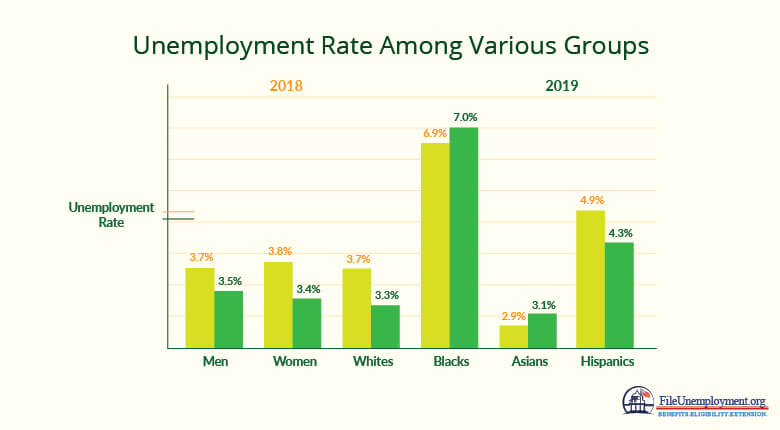The total nonfarm payroll employment in February changed a little by 20,000 as compared to January. The unemployment rate has decreased to 3.8 percent. The main reason for improvement in unemployment rate is based on professional and business services, wholesale trade, health care that saw a trend up while construction employment decreased.
Household Survey Data
The overall unemployment rate declined by 0.2 percentage point to 3.8 percent in February while number of unemployed people decreased by 300,000 to 6.2 million. Those that lost their jobs and completed temporary jobs declined by 225,000. The decline could be based on the return of federal workers to work that were furloughed in January due to the partial government shutdown.
Looking at the unemployment of various groups, you can get an understanding of unemployment situation based on how it has fared in the same month in the previous year.
| Group | Unemployment Rate (February 2019) | Unemployment Rate (February 2018) |
| Men | 3.5 | 3.7 |
| Women | 3.4 | 3.8 |
| Whites | 3.3 | 3.7 |
| Blacks | 7.0 | 6.9 |
| Asians | 3.1 | 2.9 |
| Hispanics | 4.3 | 4.9 |
People that were long-term unemployed remained unchanged at 1.3 million and accounted for 20.4 percent of the total unemployed. The labor force participation has changed a little over a year with a rate at 63.2 percent. Similarly, the employment-population ratio was at 60.7 percent. This remained unchanged over the month as it was up by 0.3 percentage points over last year.
Based on economic reasons, the number of people employed part time decreased by 837,000 to 4.3 million in February. This decline follows a sharp increase in January which was a result of the federal government shutdown.
Also in February, 1.4 million people were marginally attached to the labor force and this decreased by 178,000 since the previous year. These individuals were not part of the labor force, were available to work and were actively looking for a job in the past 12 months. Another group were the 428,000 discouraged workers in February which changed very slightly from the previous year. While the remaining 1 million people marginally attached to the labor force had not searched for work due to reasons like family responsibilities and school attendance.
Establishment Survey Data
While the total nonfarm payroll employment remained little changed of 20,000 after increasing by 311,000 in January. Similarly, in 2018 it average at 223,000 per month. But in February the main sources of employment were in professional and business services, wholesale trade and health care. But at the same time employment of construction declined.
The professional and business services continued to edge up at 42,000 with its average monthly gain of 12 months. Health care added 21,000 jobs with over 361,000 jobs added over the year. Even employment in the ambulatory health care services increased by 16,000.
The wholesale trade employment has an upward trend of 11,000. The industry added 95,000 jobs over the year which is largely among the durable goods wholesalers.
But in February, construction employment declined by 31,000 which was due to a partial offset of an increase of 53,000 jobs in January. The main employment in construction declined in heavy and civil engineering construction was 13,000. But over the year, construction added 223,000 jobs. Similarly, manufacturing employment changed little in February to 4,000 after an increase of 22,000 per month.
The month of February saw that the employment in the leisure and hospitality industry remained unchanged after it posted job gains of 89,000 and 65,000 in January and December. Over the year, it has added 410,000 jobs. There was little or no change in major industries like retail trade, mining, transportation, warehousing, financial activities and government.
Revised Data
The change in total nonfarm payroll employment was revised from 222,000 to 227,000 and saw a change in January from 304,000 to 311,000. Based on these revisions, employment gains in both December and January were 12,000 more than it was reported earlier. After the revisions, the job gains now average at 186,000 per month in the last 3 months
